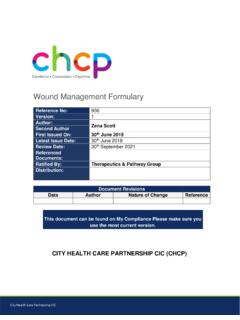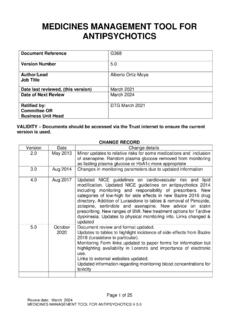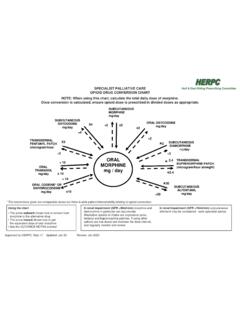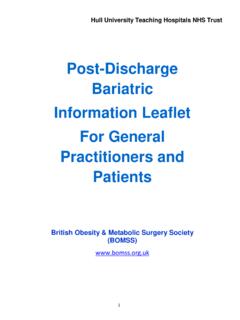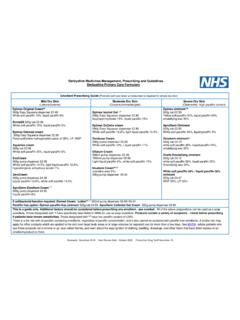Transcription of Hull & East Riding Prescribing Committee
1 hull & east Riding Prescribing Committee Prescribing Guideline: Pregabalin & Gabapentin Approved HERPC: Sept 2015 Updated: March 2019 Review Date : March 2022 Guidelines for the Prescribing of: The Initiation, management and Discontinuation of Pregabalin and Gabapentin Prescribing for neuropathic pain in Primary Care 1. BACKGROUND Neuropathic pain (NeP) is defined as a pain arising as a direct consequence of a lesion or disease affecting the somatosensory system. While nociceptive pain is produced by direct damage to the tissues involved, abnormally stimulated nerves are believed to play a key role in NeP.
2 This can result from nerve damage caused by trauma or certain conditions: Diabetes - Herpes zoster (shingles) - Trigeminal neuralgia. NeP may often be suspected or identified through some of the classical descriptions of the pain that patients can give, such as: burning, shooting, tingling, electric shocks, sharp, nagging, walking on hot coals . The pain is often worse at night, and may be paroxysmal or continuous. Characteristic signs and symptoms are: Hyperalgesia increased sensitivity to a normal pain stimulus, temperature Allodynia pain created by a stimulus that does not ordinarily produce pain, application of a cotton swab, wearing of clothes Autonomic signs include skin changes such as oedema, shininess, change of perspiration Motor dystonia, weakness and paralysis, and fasciculations.
3 Patients beliefs and perceptions of the pain and its cause, coping strategies, mood changes, disturbed sleep, and anxiety all need to be addressed. Therefore, treating anxiety or depression first might also reduce the need for analgesics. Pregabalin and gabapentin have a well-defined role in the treatment neuropathic pain as per NICE CG173 and local Prescribing guidelines. Prescribers should also be aware that use of pregabalin and gabapentin can lead to dependence and may be misused or diverted as highlighted in recent Public Health England Advice.
4 From 1st April 2019, gabapentin and pregabalin will be reclassified as Schedule 3 controlled drugs under the Misuse of Drugs Regulations 2001. 2. Aim The principal aim of these guidelines is to provide additional information to enable non specialist GP prescribers to initiate and manage treatment of patients with gabapentin and pregabalin prior to patients referral to specialist clinics in line with the local HERPC guidelines managing chronic non-malignant pain in adults. 3. Initiation These guidelines for management of chronic non-malignat pain, including NeP can be found at The guidelines for neuropathic pain (not diabetic neuropathy) recommend gabapentin as 1st or 2nd line treatment.
5 Pregabalin is recommended only if gabapentin is not tolerated. Prescribers should set realistic expectations and treatment goals. Achieving pain free status is not always achievable. Reduction in pain by 50% is a commonly used endpoint in clinical trials. Screening tools can also be useful to aid diagnosis: the Neuropathic Pain Scale (Appendix 1) 1 to 10 is a well-known validated scale. Evidence supports the validity of the scale items for detecting change in pain after treatments. hull & east Riding Prescribing Committee Prescribing Guideline: Pregabalin & Gabapentin Approved HERPC: Sept 2015 Updated: March 2019 Review Date : March 2022 It is useful to have an indication of when to stop a medication.
6 There is a period of dose titration to response. If there has been no response to treatment within two-to four weeks, after titration to adequate dose, patients are unlikely to develop a response thereafter. Integral to success is regular re-assessment of the patient and stopping medication that is not working effectively. Nice Guidelines:Neuropathic pain-pharmacological management -NICE guidelines CG 173 (update April 2018) 4. Review Throughout NeP management patients should be reviewed regularly to optimise treatment.
7 During these reviews the patient should be asked if the gabapentin/pregabalin prescribed has made a difference to the pain (Neuropathic Pain Scale) If the patient does not experience improved pain relief or if the pain has resolved consider stopping. Current evidence suggests that the risk of misuse may be greater with pregabalin than gabapentin. Consider changing patients to gabapentin who have never previously tried gabapentin for NeP rather than continuing with pregabalin. Community pain clinics promote exercise for NeP patient.
8 These patients should be reviewed to consider stopping NeP Prescribing once exercise eases the symptoms of pain. Switching pregabalin to gabapentin in patients with normal renal function Pregabalin is indicated for peripheral & central neuropathic pain and gabapentin for peripheral neuropathic pain. Beware of converting or switch these medications purely based on dosing (Reference CG173) If switching is appropriate, this would be a straight switch, rather than titrating down the pregabalin dose and titrating up the gabapentin dose.
9 Pregabalin total daily dose pre-switch Gabapentin total daily dose post switch (Toth study8) Suggested daily dose of gabapentin 150mg 900mg 300mg tds 225mg 901mg to 1500mg 400mg tds 300mg 1501mg to 2100mg 2x300mg tds 450mg 2101mg to 2700mg 2x400mg tds 600mg 2701mg to 3600mg 3x300mg tds For daily doses of pregabalin below 150mg daily, 100mg, 75mg switch to gabapentin 100mg tds, and titrate up if necessary. Renal impairment: dose reductions are recommended for both pregabalin (CrCl<60ml/min) and gabapentin (CrCl< 80ml/min).
10 If appropriate to switch, please also refer to for further information on recommended dose of gabapentin. 5. Discontinuing The summary of product characteristics for gabapentin and pregabalin indicate that both drugs can be discontinued over one week. A more gradual dose taper allows observation of emergent symptoms that may have been controlled by the drug. hull & east Riding Prescribing Committee Prescribing Guideline: Pregabalin & Gabapentin Approved HERPC: Sept 2015 Updated: March 2019 Review Date : March 2022 Pregabalin: reduce the daily dose at a maximum of 50-100mg/week.
